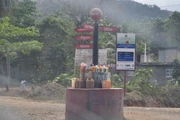Limbé (Haitian Creole: Lenbe) is an arrondissement in the Nord Department of Haiti. As of 2015, the population was 106,201 inhabitants. Postal codes in the Limbé Arrondissement start with the number 16.
The arondissement consists of the following municipalities:

Location in Haiti
1. Limbé🏛️
2. Bas-Limbé (incl. Limbé Island)
3. Labadee
Neighboring Arrondissements
| North⬆️ | [Atlantic Ocean] |  |
|---|---|---|
| South⬇️ | Marmelade and the Saint-Raphaël Arrondissements |
  |
| East➡️ | Cap-Haïtien Arrondissement |  |
| ⬅️West | L'Acul-du-Nord Arrondissement |  |
Meet the Municipalities[]
Limbé 🏛️ (85,302) Before becoming a satellite city of the much larger Cap-Haïtien, capital of the North, this medium-sized settlement has its origins in agriculture, specifically sugar cane. Rich, wooded and fertile, the region is agriculturally quite well exploited. Its rice production and banana plantations are extremely important for the northern region of the country. Strategically located on National Highway 1, the city, over time, has become a place of meeting and supply for traders and truckers from surrounding municipalities such as Pilate, Port-Margot, and other localities of lesser importance. The local economy is largely based on agriculture (timber, honey, mango, coffee, and banana). The commune is home to Guahaba Museum, dedicated to the native artifacts of the Amerinian tribes, and Fort Dahomey, one of about twenty military structures built on the territory of Haiti after independence in 1804.
Bas-Limbé (incl. Limbé Island) (20,899) On the edge of a picturesque coastline, not far from the city of Cap-Haïtien and near the RN1, stands this dynamic town with enormous agricultural and recreational-tourist potential. From the top of the hill overlooking the vast plain, between the marvelous beach and agricultural fields, a unique panorama of lush vegetation imposes itself on the view. The local economy is based on agriculture (plaintains, sugar cane, corn, and fruits), livestock, and commerce. The fields are watered by the Limbé River.
Michael VedrineMichael Vedrine
